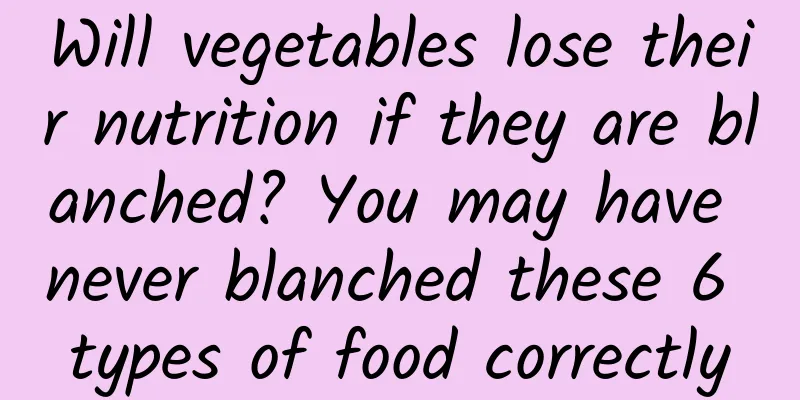Will vegetables lose their nutrition if they are blanched? You may have never blanched these 6 types of food correctly

|
"Blanching vegetables will lose a lot of nutrients, so it's better not to blanch them?" Some people on the Internet believe that many nutrients in vegetables are not resistant to high temperatures, and blanching will decompose these nutrients and reduce the nutritional value of vegetables. Rumor Analysis This statement is not rigorous. There are many kinds of vegetables, and they contain different nutrients. Some vegetables also contain substances that are harmful to the human body. Proper blanching can not only preserve nutrients to the maximum extent, but also help remove harmful substances in vegetables. Blanching is a common cooking process for many friends, but some friends hold different opinions on this point, thinking that blanching will reduce the nutritional value of vegetables. Regarding this question, it can be said with certainty that for many vegetables, blanching is the right choice , but there are also many precautions when blanching, which can help us preserve nutrients as much as possible and remove harmful substances. For example, which ingredients need to be blanched, and do we need cold water or hot water? … Blanching is healthy and life-saving if done correctly, but nutrition and taste will be greatly reduced if done incorrectly. In this article, we will take stock of the ingredients that need to be blanched and how to blanch them correctly. Which ingredients need to be blanched? 1 Vegetables high in oxalate Oxalic acid is an anti-nutrient found in many vegetables, but the content varies. Excessive intake of oxalic acid in the daily diet can form insoluble substances with calcium before absorption, hindering the absorption of calcium. After absorption, it can form insoluble oxalates with calcium and other substances in the body, increasing the risk of stones. Vegetables such as Chinese cabbage, small white radish, cabbage, mung bean sprouts, and carrot tops have very low oxalic acid content and can be eaten with confidence. However, vegetables such as spinach, water spinach, celery, amaranth, and purslane have relatively high oxalic acid content and need to be pre-processed to remove oxalic acid before eating . Copyrighted stock images, no reproduction is authorized Fortunately, oxalic acid is easily soluble in water, and blanching in hot water can remove most of the oxalic acid. Studies have shown that when 180g of spinach is placed in 1000ml of boiling water and blanched for 1 minute, 2 minutes, 3 minutes, and 4 minutes, the removal rate of soluble oxalic acid is 43%, 50%, 54.7%, and 58.9%, respectively. However, the removal rate of oxalic acid in spinach by frying in oil is not high, not exceeding 5%, and even increasing the amount of cooking oil has little effect. In addition, purslane is quite special. Its oxalic acid content is as high as 1460mg/100g , which is more than twice that of spinach. An experiment showed that if 100g of purslane is blanched in 500ml of water for 3 minutes, the oxalic acid removal rate can reach more than 50%. After blanching for 4 minutes and discarding the soup, the oxalic acid content is 560mg/100g. [2] Although this oxalic acid content is lower than that of fresh spinach, it is still higher than that of most green vegetables, so it is better to eat less. 2 Poisonous vegetables Some vegetables contain toxins naturally. If they are not blanched or eaten raw, they may cause food poisoning, which can be fatal. 1. Beans and French beans Raw beans and green beans contain saponins . Saponins contain hemolysins that can destroy red blood cells. They have a strong irritating effect on the gastrointestinal mucosa, causing congestion, swelling and hemorrhagic inflammation, and can cause symptoms such as nausea, vomiting, abdominal pain, and diarrhea. This ingredient is afraid of heat. Heating at 100℃ for more than 10 minutes , or frying at a higher temperature, can cleave saponins and eliminate the toxicity of harmful substances. Blanching before cooking is a good way to avoid poisoning. 2. Fresh daylily A component in fresh daylily can cause nausea, vomiting, dry mouth and diarrhea when consumed. As for what this ingredient is, it is still unclear. In the past, people thought it was colchicine, but the latest research has put forward a different view on the "toxic ingredient" in daylily, believing that daylily does not contain colchicine, but contains a co-elution component of multiple compounds, which is easily soluble in water and can be decomposed by steaming and blanching. It can be safely eaten after boiling water for 3 to 5 minutes . 3 Vegetables high in nitrite When it comes to "nitrite", many people will think of "carcinogenic". In fact, nitrite itself is not carcinogenic, but after we eat it, it will produce nitrosamines in the environment of gastric acid. Nitrosamines are carcinogens, and excessive intake will increase health risks. Therefore, vegetables with high nitrite content must be blanched before cooking. Researchers have evaluated the sanitation and safety of vegetables in a suburb of Shanghai and found that the nitrite content in fresh vegetables is generally low, with the highest nitrite content in leafy vegetables being 19 mg/kg, and the nitrite content in onions, garlic, melons, beans, aquatic vegetables, and nightshade vegetables is even lower, with some vegetables containing less than 0.1 mg/kg. Although you can eat them without worry, the nitrite content in leafy vegetables is higher than that in other vegetables, and the nitrite content in Chinese toon is more prominent among leafy vegetables . However, don't worry, blanching can reduce the nitrite content in vegetables. Someone bought 6 samples of Chinese toon from farmers' markets and supermarkets. The nitrite content was between 100 and 500 mg/kg. Washing it three times could remove more than 50% of the nitrite, and the nitrite content was between 50 and 200 mg/kg. Blanching it for one minute could remove more than 90% of the nitrite, and the nitrite content was between 10 and 50 mg/kg. Therefore, don’t eat Chinese toon with dipping sauce. Even if you want to scramble eggs, you have to blanch it first. Copyrighted stock images, no reproduction is authorized 4 Vegetables that may be contaminated by parasites Aquatic plants are likely to be contaminated by parasites. For example, the water chestnuts, lotus roots, and water caltrops that we often eat should not be used directly to make cold dishes. They are likely to be infected with ginger worms, which can cause mild symptoms such as abdominal pain, diarrhea, nausea and fever. In severe cases, it can cause intestinal obstruction and even death. Blanching and then mixing it with cold water can ensure food safety. 5 Difficult to clean vegetables Some vegetables have uneven surfaces and many pits and holes, which can easily hide dirt and pesticide residues. For example, broccoli, cauliflower, and fungus are not easy to clean, and there may be dirt and insect eggs in the gaps. However, broccoli is relatively rich in vitamin C among vegetables. Don’t blanch it for too long to avoid the complete loss of vitamin C. Generally, blanching it for 1 to 2 minutes is sufficient . 6 Foods with blood or a strange smell Animal foods such as spare ribs, mutton, and pig intestines may carry blood or odors. Blanching can reduce their impact and improve the quality of the dishes. While blanching, you can add cooking wine, bay leaves, star anise and other spices to remove the fishy smell and enhance the flavor. Things you need to know before blanching Blanching seems simple, as if it is just a matter of "boiling water + ingredients", but there are many things to pay attention to in the actual operation. 1. Put meat in cold water, and put seafood and vegetables in hot water Meat dishes need to be put into the pot with cold water to help skim off the blood foam. If the meat is put into the pot with boiling water, the protein on the surface of the meat will denature, and the outermost layer will be cooked directly, so that the blood inside cannot come out, and the purpose of removing blood stains cannot be achieved, and the taste will also be bad. Vegetables need to wait until the water boils before being put into the pot. Although cold blanching has a higher oxalic acid removal rate than hot blanching, cold blanching will cause greater damage to the physical structure of vegetables and cause more nutrient loss . It is recommended to blanch fish and shrimp in boiling water for 1 to 2 minutes and then remove them. This can not only remove the fishy smell but also maintain the fresh and tender taste. 2. Enough water It is best if the water can cover the ingredients. This will ensure that after the ingredients are added, the water in the pot can boil again in a short time, shortening the cooking time and reducing nutrient loss. 3. Different ingredients have different blanching times For most leafy vegetables, blanching only requires 1 minute . It is also recommended to blanch them before cutting them. After blanching, immediately place them in cold water to cool them down and drain them. Do not squeeze them excessively to avoid nutrient loss. Vegetables like bamboo shoots and wild rice stems can be boiled for a little longer . This is because the total oxalic acid removal rates of bamboo shoots and wild rice stems are 60% and 10.7% respectively when blanched for 1 minute, while the total oxalic acid removal rates of the two are 63.9% and 31.7% respectively when boiled for 3 minutes. At the same time, they themselves have very little content of heat-sensitive vitamins. The vitamin C content of bamboo shoots and wild rice stems is only 5mg/100g, and the vitamin B group content does not exceed 0.1mg/100g, so there is no need to worry about the loss of these nutrients. Broccoli, cauliflower, and fungus only need to be blanched for 1 to 2 minutes; water chestnuts, lotus roots, etc. need to be blanched in boiling water for more than 1 minute; beans and green beans are recommended to be blanched for more than 10 minutes; fresh day lily is recommended to be blanched for 3 to 5 minutes. Copyrighted stock images, no reproduction is authorized After putting the meat into the pot, wait for the water to boil again and cook for another 1 to 2 minutes until no large amount of blood foam is cooked out. 4. If you want to keep the color of vegetables, you can add a few drops of cooking oil when blanching. 5. Don’t reuse the water used to blanch vegetables Oxalic acid is soluble in water. The longer the blanching time, the higher the oxalic acid content in the soup. If you don't know whether the vegetables you want to eat need to be blanched, then just boil them. Drain the water from the vegetables after they are out of the pot, add some steamed fish soy sauce or light soy sauce, and drizzle with sesame oil or linseed oil, and you have a delicious dish! Boiling is a low-temperature cooking method. Compared with stir-frying, frying, and deep-frying, it can retain more nutrients and avoid the production of harmful substances. It is quite recommended! Looking in the mirror of rumors We can see that although they are all called "vegetables", in fact, different vegetables have different nutritional components, different heat resistance, and different harmful substances. Therefore, we can neither generalize nor be embarrassed. It is most convenient to read relevant popular science articles and directly follow the experimental results and conclusions of researchers. References [1] Xia Wei. Effects of cooking on oxalic acid in vegetables[D]. Suzhou University, 2007. [2] Zhou Sannu, Liu Liqing, Wu Xianhui, Tian Yanji, Pan Bin. Differences in oxalic acid content in fresh, boiled and harvested purslane[J]. Agricultural Products Processing, 2016(23):52-54.DOI:10.16693/j.cnki.1671-9646(X).2016.12.014. [3] Yang Mingfang, Chen Wei, Yi Yanzhong, Lu Zhenyu, Hu Jun. Laboratory analysis of a kidney bean saponin poisoning incident[J]. Chinese Journal of Health Laboratory Technology, 2018, 28(12): 1520-1522. [4] Ma Wei, Gao Jie, Xing Qian, Zhao Dan, Zheng Xiaonan, Jie Minchang. Safety analysis of fresh daylily[J]. Modern Food, 2021(23):153-155. DOI:10.16736/j.cnki.cn41-1434/ts.2021.23.045. [5] Zhu Weifang, Zhan Xiuping, Song Jia, et al. Nitrate and nitrite content in vegetables and dietary intake risk assessment in a suburban area of Shanghai[J]. Quality and Safety of Agricultural Products, 2023(02):89-93. [6] Cong Yunxia, Ding Shijie, Yang Yang. Research on nitrite in Toona sinensis[J]. Food Safety Guide, 2021(19):74-75. DOI:10.16043/j.cnki.cfs.2021.19.053. [7] Yang Yuexin. Chinese Food Composition Table 6th Edition Volume 1[M]. Peking University Medical Press, 2018 Author | Xue Qingxin, one of the first nutrition instructors of the National Health Commission, a registered nutritionist in China Review | Gu Chuanling, Deputy Secretary General of Capital Health Nutrition and Gourmet Society, Registered Dietitian The cover image and the images in this article are from the copyright library Reprinting may lead to copyright disputes |
>>: What is flowing out of this tree? Can it also generate electricity for new energy vehicles?
Recommend
Gaia's "Zero-Basic Novice Short Video Monetization Training Camp" new account has a million traffic in 3 days and breaks the weight
Course Contents: Chapter 1 How to monetize short ...
Interpretation of the data monitoring and optimization methods of online alliance promotion
1. Network Alliance Data Monitoring After an ente...
A detailed explanation of shared power banks (with operation strategies)
The author of this article conducted a market ana...
Why is it always China Telecom that leaks information?
Around the 22nd of last month, an internal speech...
Baidu bidding actual consumption is 20% higher than the budget. What is the purpose of this?
When I went to do the statistics today, I found t...
7 simple ways to quickly understand user dads through online data
No matter what kind of marketing we do, we need t...
Why do people pick their noses? Will picking your nose make your nostrils bigger?
1. Why do people like to pick their noses? Becaus...
Three confirmed cases were found at a construction site in Beijing! What exactly happened? How did you get infected? Details attached!
Recently, the epidemic in Beijing has become a fo...
App Store submission review guide, worth reading!
Introduction: When uploading new products to the ...
In a blink of an eye, crayfish shells have been transformed from "kitchen waste" into "little experts" in capturing microplastics!
Author: Shi Xiangqi and Li Chuanfu Microplastic p...
Brand hit strategy!
First, let us think about a question: when we run...
The choice between light and heavy: Vancl’s seven-year cycle
If life could only be like the first time we met,...
China Passenger Car Association: Wholesale sales of new energy passenger vehicles by manufacturers in June 2023
New energy passenger car market forecast for June...
Why can a weak drop of water penetrate a hard rock?
Listen to some geological knowledge and understan...
NIO: By June 2024, NIO delivered a total of 21,209 new cars, a year-on-year increase of 98%
NIO officially announced that in June 2024, NIO d...









